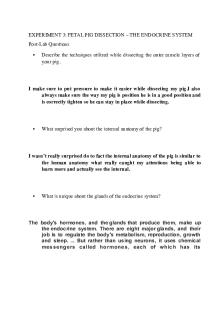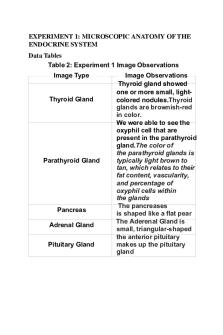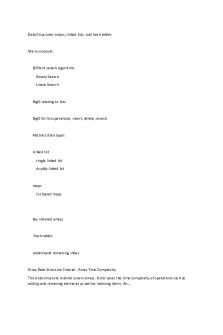Experiment 3 Data Tables and Assessment(1)-5 PDF

| Title | Experiment 3 Data Tables and Assessment(1)-5 |
|---|---|
| Author | ania ojeda |
| Course | Professional Nursing I |
| Institution | Florida International University |
| Pages | 2 |
| File Size | 57.8 KB |
| File Type | |
| Total Downloads | 31 |
| Total Views | 127 |
Summary
helpful for nursing school...
Description
EXPERIMENT 3: FETAL PIG DISSECTION – THE ENDOCRINE SYSTEM Post-Lab Questions •
Describe the techniques utilized while dissecting the outer muscle layers of your pig.
I make sure to put pressure to make it easier while dissecting my pig.I also always make sure the way my pig is position he is in a good position and is correctly tighten so he can stay in place while dissecting.
•
What surprised you about the internal anatomy of the pig?
I wasn’t really surprised do to fact the internal anatomy of the pig is similar to the human anatomy what really caught my attentions being able to learn more and actually see the internal.
•
What is unique about the glands of the endocrine system?
The body's hormones, and the glands that produce them, make up the endocrine system. There are eight major glands, and their job is to regulate the body's metabolism, reproduction, growth and sleep. ... But rather than using neurons, it uses chemical messengers called hormones, each of which has its
own unique function.
•
Explain the function of the thyroid gland and the hormones it secretes. Include how hormone release is regulated and what cells the hormones act on.
The thyroid gland is a vital hormone gland: It plays a major role in the metabolism, growth and development of the human body. It helps to regulate many body functions by constantly releasing a steady amount of thyroid hormones into the bloodstream.During hormone regulation, hormones are released, either directly by an endocrine gland or indirectly through the action of the hypothalamus of the brain, which stimulates other endocrine glands to release hormones in order to maintain homeostasis. given hormone usually affects only a limited number of cells, which are called target cells. A target cell responds to a hormone because it bears receptors for the hormone....
Similar Free PDFs

Chem111 Experiment 3 Data
- 3 Pages

Tables (Design Data) 313
- 58 Pages

Experiment 7 Data Observations
- 4 Pages

homework 3 - truth tables
- 6 Pages

Wills and Administration Tables
- 3 Pages

Truth Tables and Tautology
- 3 Pages

Formula sheet and tables
- 101 Pages

Triola Formulas And Tables
- 8 Pages
Popular Institutions
- Tinajero National High School - Annex
- Politeknik Caltex Riau
- Yokohama City University
- SGT University
- University of Al-Qadisiyah
- Divine Word College of Vigan
- Techniek College Rotterdam
- Universidade de Santiago
- Universiti Teknologi MARA Cawangan Johor Kampus Pasir Gudang
- Poltekkes Kemenkes Yogyakarta
- Baguio City National High School
- Colegio san marcos
- preparatoria uno
- Centro de Bachillerato Tecnológico Industrial y de Servicios No. 107
- Dalian Maritime University
- Quang Trung Secondary School
- Colegio Tecnológico en Informática
- Corporación Regional de Educación Superior
- Grupo CEDVA
- Dar Al Uloom University
- Centro de Estudios Preuniversitarios de la Universidad Nacional de Ingeniería
- 上智大学
- Aakash International School, Nuna Majara
- San Felipe Neri Catholic School
- Kang Chiao International School - New Taipei City
- Misamis Occidental National High School
- Institución Educativa Escuela Normal Juan Ladrilleros
- Kolehiyo ng Pantukan
- Batanes State College
- Instituto Continental
- Sekolah Menengah Kejuruan Kesehatan Kaltara (Tarakan)
- Colegio de La Inmaculada Concepcion - Cebu







